2018 ITG Conference Report - Day 3 - Thursday, May 31 - Daytime events
The 43rd Annual International Trumpet Guild Conference - San Antonio, Texas (USA)
Special Daily Report • Compiled by Peter Wood
Photos by Michael Anderson, Norman Bergstrom, Josh Rzepka, Denny Schreffler, and Brian Shook
Thursday, May 31, 2018 - Daytime events
Click here for more photos from the ITG Conference
Wayne Bennett—Warm-Up Session: The Five-Points Warm-up & Technical Routine: Building Consistency on a Time Budget
Dr. Wayne Bennett began his warm-up session explaining his Five-Points Technical Routine, which is built on “specific technical points of tone, flow, range, flexibility, and articulation.” Bennett provided a handout of specific exercises within each category. He emphasized that the routine is very adaptable to the amount of practice time available and can include exercises from personal preferred methods. The warmup began with singing a short scale study and then buzzing it on the mouthpiece. Exercises to work on tone and flow included a modified Schlossberg #9 exercise and a modified Cichowicz Flow Study, which he encouraged playing with a drone. Range exercises included scale and arpeggio passages with the emphasis on fluidity and playing easily from low to high. With the remaining points, the player should still be concentrating on tone and flow. The session finished up with a flexibility study from the Bai Lin book and articulation studies that included single, double, and triple tonguing. (JB)
Nancy Taylor—Warm-Up Session
Comparing a warmup to a buffet, Nancy Taylor emphasized that each individual should choose methodologies that work best for them and that address their needs as a player. One important component of this early-morning smorgasbord that can benefit any player’s warmup is face isometrics. Taylor demonstrated several exercises to engage the muscles that form the embouchure that can be done in the car, at work, or anywhere else and can help maintain strength in the corners while spending time away from the horn. In discussing the physical components of playing, Taylor stressed the importance of tongue position for both articulation and playing in all registers with ease and efficiency. She provided several studies that helped the crowd of early risers quickly prepare their chops for a day of playing. Taylor’s variety of approaches provided a well-rounded selection of ideas to incorporate into any warm-up routine. (EM)
Bryan Appleby-Wineberg and Tom Hutchinson Presentation—Cornet Tricks and Quick Answers
Cornet Tricks and Quick Answers was a highly insightful presentation by Bryan Appleby-Wineberg (Rowan University) and Tom Hutchinson (Royal Welsh College of Music and Drama), focused on how to approach one’s development on the cornet. The presentation highlighted numerous aspects of cornet and brass band performance, including sound, vibrato, equipment, and showed how outsiders of this community can begin to understand the idiosyncrasies of this genre. Both Appleby-Wineberg and Hutchinson shared personal stories about their experiences performing in brass bands and competitions and talked about how they each approach finding their own sounds on the cornet. (JPS)


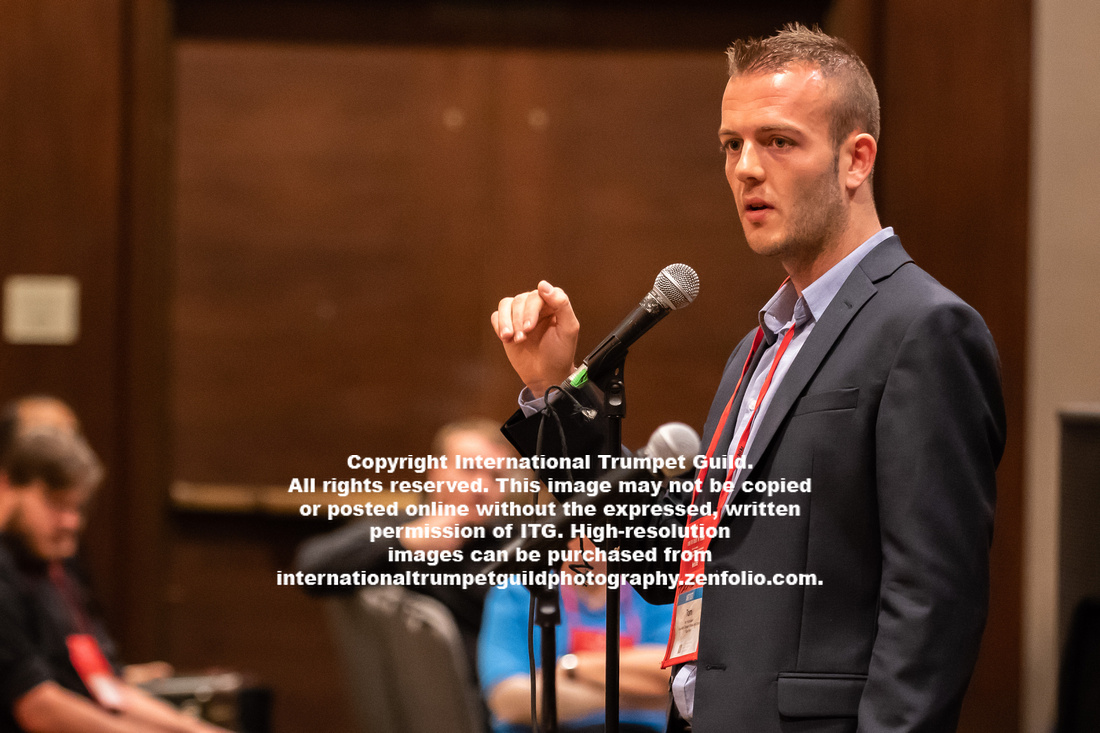

David Vining—Non-Pro/Comeback Player Presentation: Using Body Mapping to Prevent Injury and Become More Efficient
David Vining, professor of trombone at Northern Arizona University, brought his engaging pedagogy and expertise on body mapping, or learning the truth of how our bodies are constructed and how we are intended to move, to promote more efficient and healthier brass playing. By focusing on replacing compromised breathing with efficient, relaxed breathing, brass players can eliminate tension in their playing while developing a quality sound and ease of playing. Vining discussed how body mapping empowers the individual to refine his/her own movements based upon personal exploration. Vining focused on the self-exploration and self-awareness needed to determine how a player’s fluid, personal balance differs from the stagnant exterior look of good posture. Vining discussed his personal journey with focal dystonia and how his knowledge of and journey through body mapping discovery helped him overcome his struggles and led to his teaching the technique as a mechanism for injury prevention. (AJ)
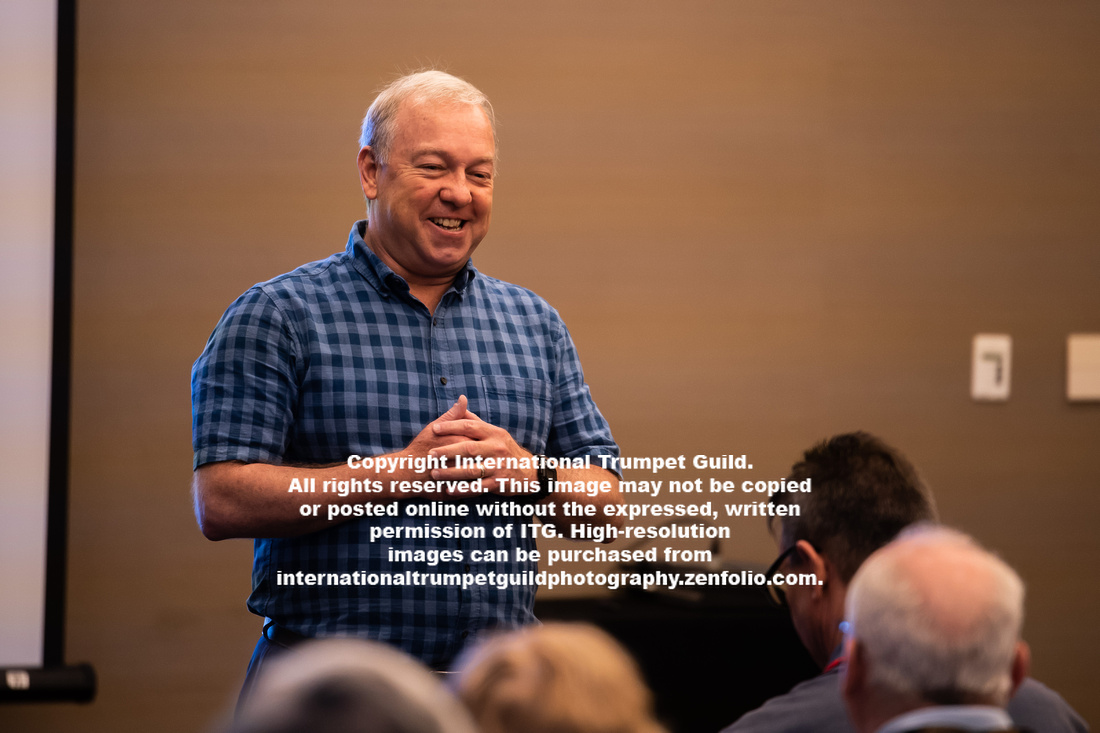

ITG Orchestral Excerpts Competition Finals
The final round of the ITG Orchestral Excerpts Competition was a superb presentation of trumpet playing as each competitor performed a diverse and challenging list of standard excerpts. The first finalist to perform was Nick Nusser (student of Ryan Gardner at Oklahoma State University), who demonstrated excellent musical style. He performed Donizetti’s Don Pasquale with a beautiful sound that was filled with musical expression. Maximillian McNutt (student of Scott Thornburg at Western Michigan University), the second finalist to perform, exhibited exceptional power and beauty throughout each excerpt, particularly in his captivating performance of the opening solo from Mahler’s Symphony No. 5. Ian Mertes (student of Ryan Gardner of Oklahoma State University) was the third and final competitor to perform. He displayed a brilliant sound with great musicality on each excerpt. He presented Bach’s Magnificat with great finesse and beauty on the piccolo trumpet. The judges for this final round of the competition were John Carroll, principal trumpet of the San Antonio Symphony; Philip Smith, professor of trumpet at the University of Georgia and former principal trumpet of the New York Philharmonic; and Marie Speziale, former associate principal trumpet of the Cincinnati Symphony Orchestra. (JBr)
New Works Recital II
Mervin Tay’s Timeless for trumpet and piano includes a lively opening inspired by Alexander Goedicke’s Concert Etude but then deeply explores the lyrical capabilities of the trumpet with lush harmonies. David Amlung presented a beautiful performance that also included a few very lontano Harmon-muted notes that almost sounded as if they were in a different room. This very accessible new work in terms of technical demands and harmonic palate has considerable appeal. (LE)
Performed by Doug Lindsey on E-flat trumpet, Brett Miller’s Running from the Rain evokes a reflective and pensive mood, inspired by the composer’s being caught in a storm while on a bike ride. Miller used that musical imagery to represent times when people are running from things in their own lives. Lindsey and pianist Miriam Hickman’s playing artfully captured the essence with the nimbleness of the melody, creating a light and nervous texture, all while conveying the depth of the subject to the listeners. (KM)
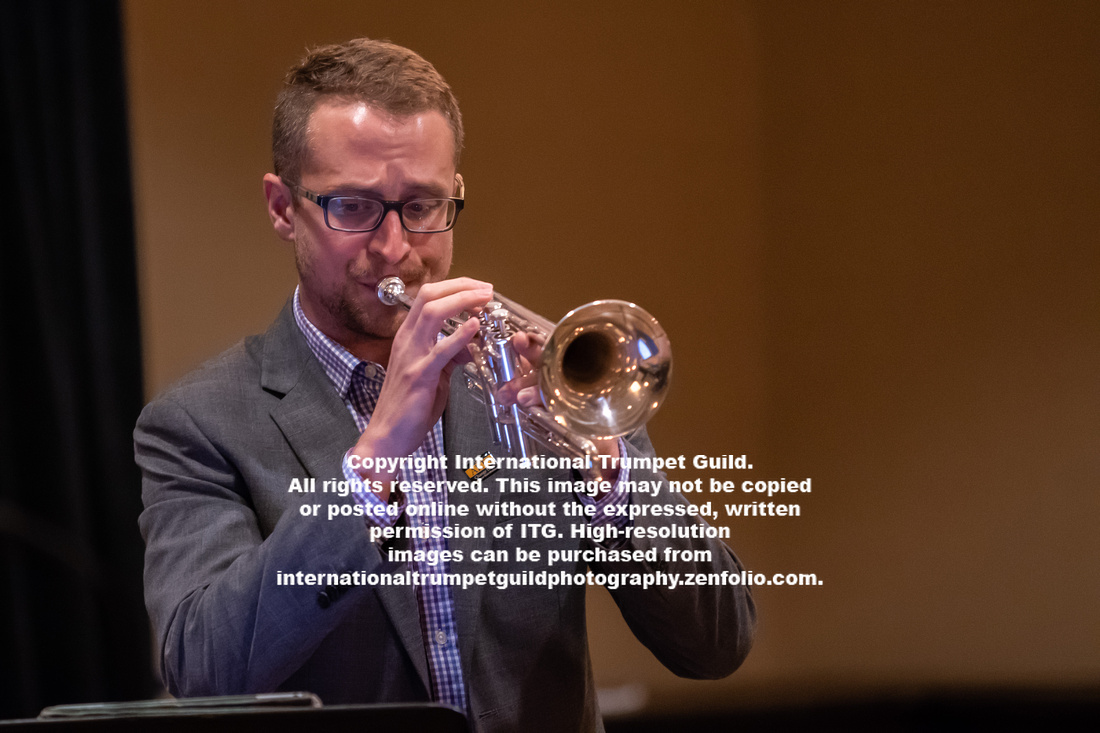

In five short movements, Michael Cotten’s Song Cycle for Trumpet Unaccompanied provides great diversity of style between the movements. These include a bold opening with “A Tale Begins,” flowing technical sections in “Butterflies in the Redwoods,” folk-like melodies in “Flowering Song,” a cheeky excursion with “A Waltz Remembered,” and a dramatic conclusion with “The Tale Ends.” With a well-paced performance, Marisa Youngs enhanced the stylistic differences in each part of the story. (LE)
Beginning with a simple quarter-note pattern, Justin Rito’s Circadian Rhythm, performed by Josh Ganger on flugelhorn and Miriam Hickman on piano, seemed unassuming. As it developed, it cycled through a variety of moods and rhythmic foundations that were communicated effectively by the performers. Throughout the middle, there was a sense of rushed expression with Ganger moving with the melody through wild lines in the flugelhorn’s upper register and Hickman’s quarter-note rhythm turning to incomplete triplets. To complete the cycle, the work calms back down, ending similarly to how it began. (KM)
Soloist and composer Stanley Curtis has been composing works based on stained glass windows at his church for several years, and his Advent for soprano, trumpet, and piano follows this trajectory. The lyrics are taken from “Advent” from The Back Chamber by Donald Hall, and the music included many cantabile melodies for the trumpet and interesting textures as Curtis and pianist Benjamin Keseley often joined forces to accompany soprano Tia Wortham. This mature work was presented with an exceedingly polished performance. (LE)
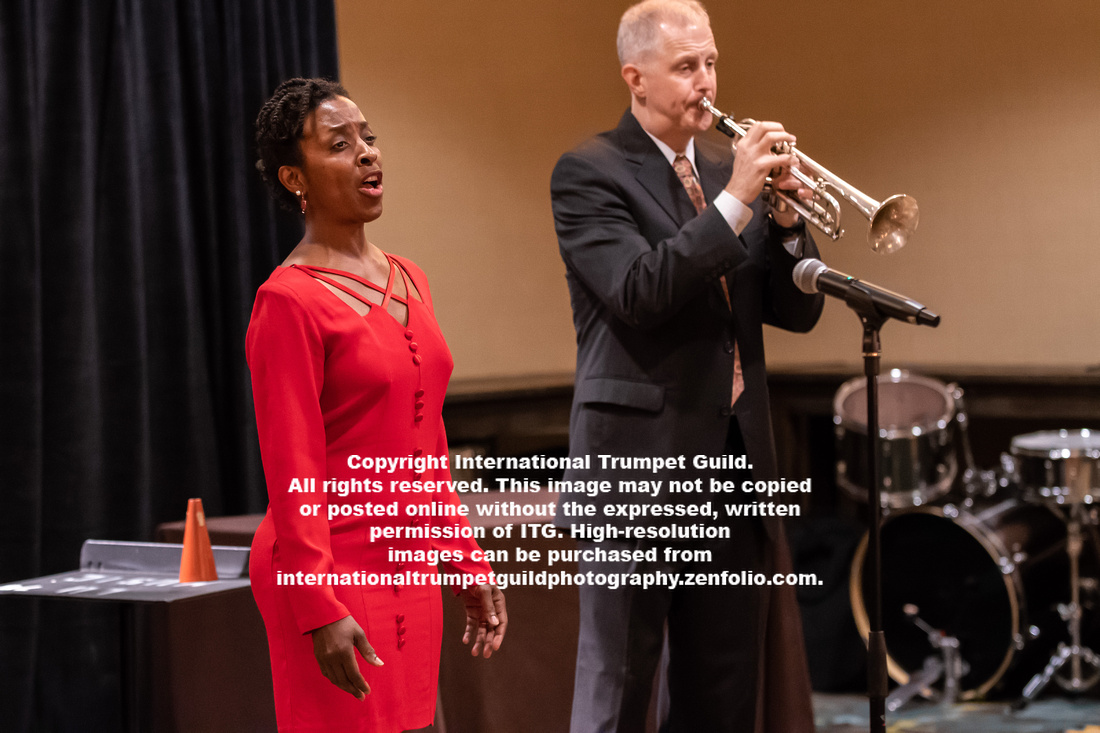

The final piece of the recital was Brendan Collins’s Sonata for Trumpet and Piano, performed by Garrett Klein on trumpet and flugelhorn and Miriam Hickman on piano. Klein chose to perform the third movement on flugelhorn, an option suggested by Collins. The first movement focuses harmonically around the perfect fifth, highlighted in the opening chorale before moving into the rest of the movement. Rhythmically, the first two movements allowed Klein and Hickman room to showcase the interplay expected in a sonata, with lots of vitality in the melodic motives. The second movement is significantly shorter than the outer two and has a fun character. The third movement is the most different, with its tender character, and is very well suited to performance on the flugelhorn. (KM)
Recital: Philippe Litzler
Rebecca Wilt joined Philippe Litzler, solo trumpeter for the Zurich Tonhalle Orchestra, in a beautiful recital. He began his performance with Joseph Haydn’s Trumpet Concerto in E-flat, which included a dazzling third movement that highlighted Litzler’s technical prowess and musicianship. Next came Guy Ropartz’s Andante and Allegro, a standard from the French conservatoire repertoire, which Litzler handled with ease. Litzler concluded his recital with sonatas by Karl Pilss and Jean Hubeau. Both challenging in their own right, Litzler performed them with grace and agility. The audience was even treated to a surprise encore of Thorvald Hansen’s Romance. (BC)


Recital: José Cháfer Mompó—Musical Connections
José Cháfer Mompó’s Thursday afternoon recital featured two world premieres. Accompanied by pianist Rebecca Wilt, the opening concerto by Brendan Collins was a tasteful demonstration of Chafer’s superb musicality and command of the instrument. The first of the premieres was also composed by Collins. Entitled José Suite, in honor of Cháfer, the piece consists of six brief movements in which the artists effortlessly transition between unrelated characters, scenes, and moods. Ramon Garcia Soler’s Lyric Outline was specifically written for this year’s conference and featured Cháfer gracefully navigating the upper tessitura during several expertly crafted moments with his pure, resonant sound imbuing each corner of the room with tenderness and longing. Technical prowess and mastery of the flutter tongue were on full display during Artaza. Brian Evans joined Cháfer on stage to close this performance with a lovely duet that was composed originally for cello, clarinet, and piano. (AD)
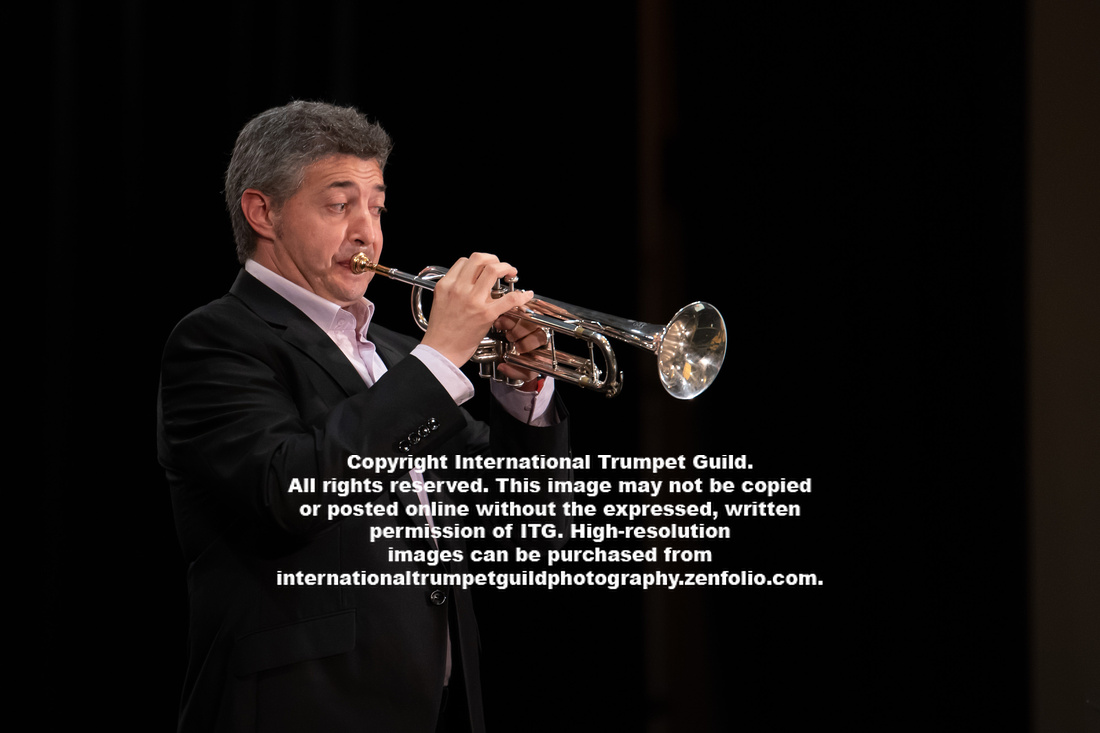

Bert Truax Presentation—Sometimes The Magic Works! And Sometimes It Doesn't…
Bert Truax opened his session with a colorful rendition of Phil Snedecor’s Lyrical Etude no. 1, illustrating the concepts and techniques he has learned over the years to keep his playing on track and survive as a professional trumpet player. Truax was a student of both Bill Adam and James Stamp and talked about those two schools of thought, stressing that it is the result that is important. Truax shared his ideas for playing and teaching a sound that is pure, focused, and vibrant and invited players to come up and try some of these techniques. He advised students to “Find people you admire and get that sound in your head. An ITG conference is the perfect place to do that.” Truax looked back over his long career with the Dallas Symphony Orchestra and as a freelance trumpeter and said, “We all have things that happen in our lives. I’ve had wonderful successes and magnificent failures.” The audience was given a quick but thorough look at how to practice fundamentals to develop and maintain a high level of performance. The session was lively and fun, with t-shirts being tossed to audience members who correctly answered questions during the talk. The presentatIon was subtitled “A thoughtful discussion with Bert Truax,” and he left us with some meaningful reflections. “We are all trumpet geeks, but at the end of the day, it’s all about the music. We all have a gift from God to raise people up with music. Even in ‘Nowhere, Texas,’ we can play from the heart. It’s all joy; it’s all about the music.” (LAH)
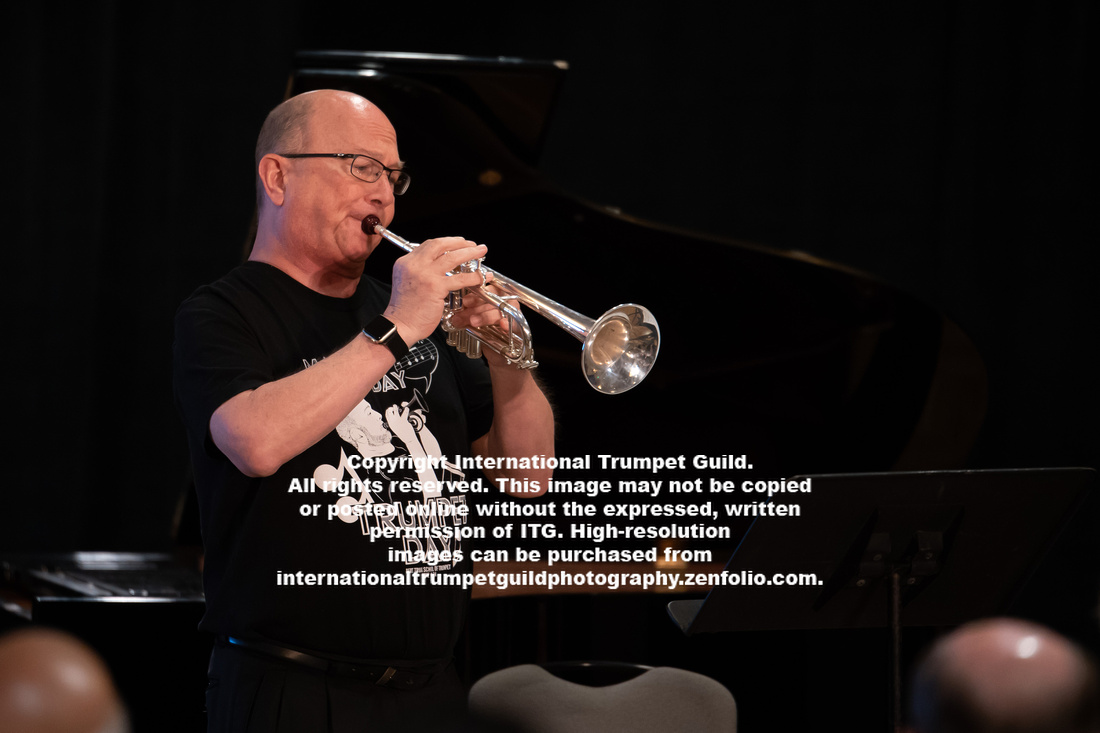

Masterclass: Philip Smith
In typical fashion, Phil Smith captivated the ITG audience with his magnificent sound and engaging personality. This particular masterclass featured the three finalists from the ITG Orchestral Excerpts Competition (Ian Mertes, Nick Nusser, and Maximillian McNutt). Each finalist chose several excerpts to perform, and Smith coached various aspects of technique and musicianship. In some instances, he gave intense technical instructions and dissected an excerpt down to a single note. Other times, he simply instructed the participant to evoke detailed mental imagery and to sing the passage in a lyrical fashion. A master teacher, Smith gave constructive criticism to these talented performers and also encouraged questions from the audience, answering with sincerity and his hallmark dry sense of humor. He concluded the session by stating that the most important aspects of performance are imagination and sound--a concept we can all take to heart. (MY)


Recital: ITG Affiliate Chapters
The ITG Affiliate Chapters Recital was a fantastic part of the conference’s Thursday activities. The music performed during the recital was diverse and engaging, ranging from duets from the Renaissance adapted and edited for two trumpets to an arrangement of Wagner’s Elsa’s Procession to the Cathedral for thirteen trumpets. There were also two world premieres, and many other charming works. Those in attendance enjoyed the variety of music that was heard, and the program was a delightful example of how the ITG Conference can contribute to the sharing of music and bringing musicians together.
Seretta Hart and Peyden Shelton performed three selections from the Six Fancies for Two Treble Instruments by Orlando Gibbons. Their exciting and enjoyable performance demonstrated exceptional technical facility and musicality as they navigated the intricate rhythms and polyphony of the newly edited and published Renaissance duets.
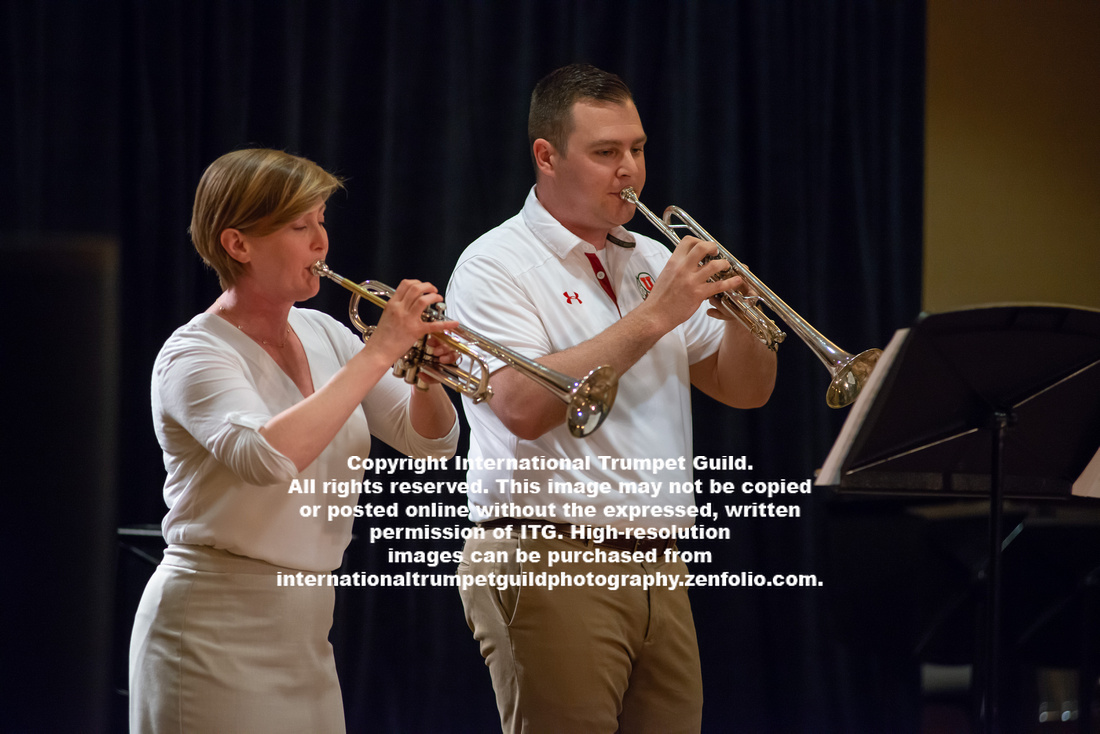

The Alabama Trumpet Guild performed the world premiere of Jeffrey Boehm’s Henrietta Park. This piece was written for six trumpets and has both jazz and classical styles intertwined throughout. The ensemble developed many different colors on this piece that contrasted solemn harmonies with brighter swing sections.
The Arkansas Trumpet Guild quartet put on a pleasing performance of Fisher Tull’s Canonical Trilogy. The group produced a well-blended sound and perfectly captured the playful aspect of the music.
The quartet from the Cincinnati Trumpet Guild played an exciting arrangement of Edvard Grieg’s Quartet in G Minor Op. 27. Each member of the ensemble demonstrated great technique.
The Lone Star State Trumpet Guild gave the world premiere of Bernard Scherr’s new work, Just Stand Up and Play. The work was performed by ten trumpeters, including the composer. The music consisted of brilliant fanfares and cascading musical lines juxtaposed across the ensemble and was a splendid contribution to the program.
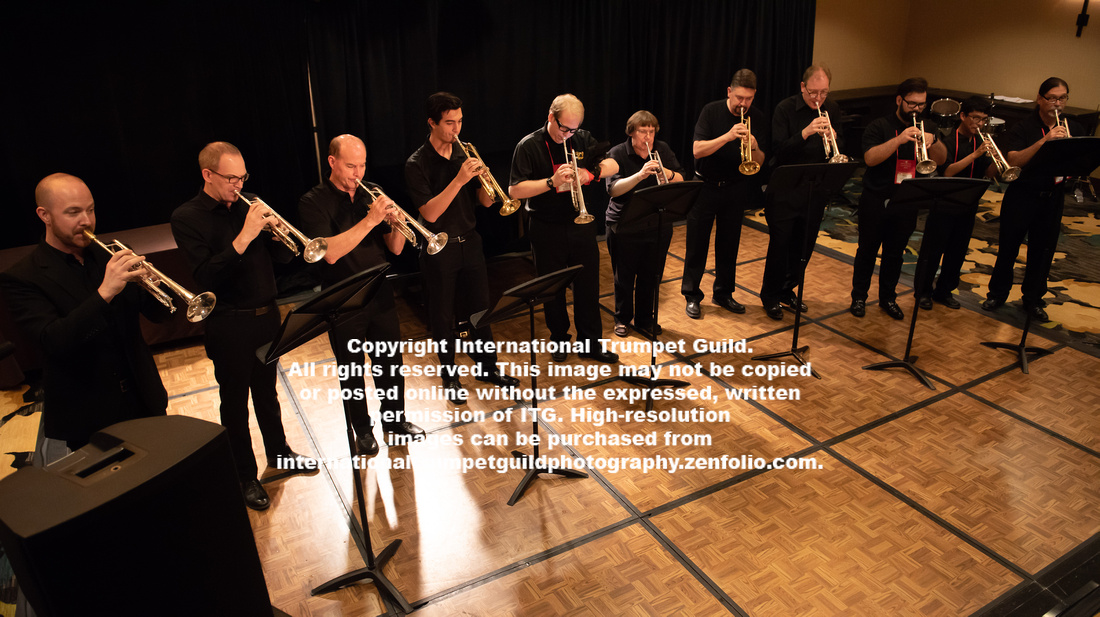
 An Overture and a Finale by Ronald Lo Presti was performed by the Louisiana State University Trumpet Guild, which consisted not only of students, but also of alumni and family members. The blended sound of the ensemble was rich and full, and the music had a pleasant modern flair.
An Overture and a Finale by Ronald Lo Presti was performed by the Louisiana State University Trumpet Guild, which consisted not only of students, but also of alumni and family members. The blended sound of the ensemble was rich and full, and the music had a pleasant modern flair.
The recital finished with the Texas A&M University – Kingsville Trumpet Guild’s performance of Richard Wagner’s Elsa’s Procession to the Cathedral, arranged by Kyle Millsap. The playing of the thirteen-member ensemble was superb, as the piccolo trumpets soared over the rich sound of the trumpets and flugelhorns. The lyrical Wagnerian melodies filled the ballroom and was a terrific finish to the recital. (SW)
Andrew Stetson Presentation—Unlocking the Teaching and Recruiting Power of Social Media
Dr. Andrew Stetson discussed how his use of social media with his studio at Texas Tech University—particularly various group pages on Facebook—has helped build a sense of community that fosters positive feedback, helps students work on conquering performance anxiety, and increases students’ ability to comment critically. With approximately ninety percent of prospective students using Facebook multiple times throughout the day, Stetson has been able to influence a larger audience that has benefited not only his current students, but also his recruiting. Stetson also discussed how the use of Facebook Live video has been able to impact his recruiting and reach a larger audience that may not be able to visit campus. This ability has enabled him and his studio to gain extra feedback from people around the world. (AJ)
Lecture Recital: Markus Würsch—The Keyed Trumpet: From Anton Weidinger’s Lost Innovations to Modern Reproductions
Markus Würsch, assisted by Shari Santorelli on piano, gave a well-attended lecture-recital consisting of literature that was originally written for the keyed trumpet. Andrew Evans, from the University of Sydney, assisted in providing much of the lecture aspect of this fascinating event. Evans detailed the biography of Anton Weidinger, trumpet virtuoso and developer of the instrument, and provided historical context for the works for keyed trumpet. Würsch, from the University of the Arts in Bern, Switzerland, performed a movement of both Haydn’s and Hummel’s concertos, complete with edits attributed to Weidinger himself. Würsch was keen to discuss the natural trumpet’s design flaws that create nearly impossible tuning and accuracy challenges on certain notes, even for a world-class soloist like himself. He also performed several lesser-known works for the keyed trumpet, and the duo ended by allowing audience members to try modern reproductions of this curious instrument. (BH)


Click here for more photos from the ITG Conference